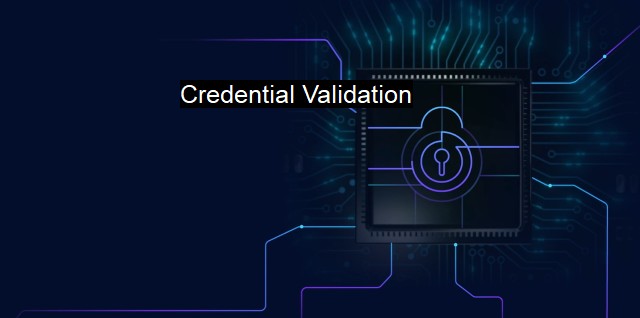What is Credential Validation?
The Importance of Credentials Validation in Cybersecurity: Ensuring Secure Access to Sensitive Data and Systems
Credential validation is a crucial aspect of cybersecurity and antivirus protection warfare where the integrity and authenticity of a user's credentials or rights are verified. In simple terms, it refers to the process of ensuring the verity of one's identity and making sure the credentials match with the stored information on a database or server. Be it a password, token, certification, or simpler measures like user ID, name, or cookies, all fall under the vast umbrella of credentials that need to be validated.When a user tries to log into a website, an email account, or a database, the website or email server running the cybersecurity runtime (defined program) verifies the entered credentials against the received data. This is perhaps the most identifiable example of credential validation. Its rigorous and sophisticated application ensures that the intended user has these credentials to avoid identity theft, unauthorized use, and similar illicit cyber activities.
To understand it more explicitly, it's helpful to consider an all too common scenario that unfolds millions of times: an individual uses their username and password to log into their email account. Credential validation occurs by comparing the entered username and password against the stored ones. Only when they match, access is granted; else, it will be rejected.
From a context of antivirus and cybersecurity, credential validation is invaluable in differentiating legitimate entities from harmful imposters. The assortment of potential threats and attack vectors commonplace within the digital landscape necessitates the validation of one's credentials. Without the validation of user credentials before deploying rights to applications, databases, or systems, malicious attackers can pose as legitimate users and gain unauthorized accesses.
An antivirus software or system routinely maneuvers the firewall to alert the device owner of any unauthorized attempt of access or compromised credentials. It operates as the first line of defense to protect from malware, trojans, etc., constituting any approach to potentially infiltrate user safety and security.
Increased cases of cyberattacks and data breaches further underscore the importance of credential validation, pressing organizations to invest seriously in antivirus software or security systems. Data was once predominantly secured within the confines of an organization's network. But with the ongoing advent of digital transformation and workplace flexibility, storing and accessing data beyond secured networks are becoming the norm. In such cases, strong credential validation strategies are pivotal in safeguarding data and maintaining the digital environment's integrity and security.
The modernized form of credential validation methods also includes two-factor authentication (2FA) or multifactor authentication (MFA), involving inputting information that only the legitimate user should know or have, like a unique One-Time-Password (OTP) sent to the registered mobile number. This provides an extra layer of security and minimizes the chances of credential thefts.
Introducing a nonce or a random number in the process makes the validation even more secure. It ensures that each validation process is unique in and of itself, procedurally preventing potential cyberattacks.
Biometric attributes such as fingerprints, facial recognition, retinal scans, and voice recognition constitute the benchmark of state-of-the-art credential validation for more sophisticated systems, providing robust levels of security and only possible impersonation through creepy science fiction methods.
Credential validation is akin to the reliable gatekeeper of the cyber world. Given the sophistication and the ever-increasing scope of cyberattacks and threats, credential validation now isn't merely desirable validation procedure—it is an essential measure of cybersecurity management and a requisite symbiotically combined with malware and antivirus software. As we tread into an era controlled almost entirely by data, practicing diligent credential validation techniques offers a resilient shield against the looming cyber threats and vulnerabilities, thereby manifesting as a guardian element of the cybersecurity world.

Credential Validation FAQs
What is credential validation?
Credential validation is the process of verifying the authenticity of a user's login information or digital certificate. This process is essential for ensuring only authorized users are granted access to a system, preventing cyberattacks and maintaining data security.Why is credential validation important in cybersecurity?
Credential validation is critical in cybersecurity because it helps to prevent unauthorized access to sensitive data and systems. By verifying the authenticity of a user's login information, it helps to protect against cyber threats, such as password cracking and brute force attacks.What are some common methods for credential validation?
Common methods for credential validation include two-factor authentication, biometric authentication, digital certificates, and password policies. These methods can be used in combination to provide increased security and prevent cyber attacks.What is the role of antivirus in credential validation?
Antivirus plays a crucial role in credential validation by scanning for malware and other types of malicious software that may attempt to steal or compromise login information. Antivirus programs can detect and eliminate threats in real-time, preventing cyber attacks and protecting sensitive data from unauthorized access.| | A | | | B | | | C | | | D | | | E | | | F | | | G | | | H | | | I | | | J | | | K | | | L | | | M | |
| | N | | | O | | | P | | | Q | | | R | | | S | | | T | | | U | | | V | | | W | | | X | | | Y | | | Z | |
| | 1 | | | 2 | | | 3 | | | 4 | | | 7 | | | 8 | | |||||||